Do you want to replace or get a new kitchen sink? But how can you know which material would work in your kitchen? We got you covered.
With the pandemic hitting, there is a rise in health awareness which makes people cook healthy meals at home. Consequently, it boosted the demand for kitchen sinks having high-quality material in our homes.
One of the high-quality and popular sink materials is stainless steel. It might be surprising, but almost 70% of the sinks are stainless steel. But, you might be wondering, are there only metallic kitchen sinks? If not, then what materials strictly come under the rest of 30%?
So, that is what I’m going to share with you today -13 different types of materials available in kitchen sinks. This article will discuss all the sink materials and their pros and cons. So, keep reading to find out what kitchen sinks are made of and what fits your kitchen.
13 Types of Kitchen Sink Materials Explained
Did you know? Research conducted on the global kitchen sink market predicted that the market is expected to expand by $615.84 million between 2021-2025 with a CAGR of 4%.
With the sink market overflowing with numerous materials. The material dictates its quality and performance. Some sink materials are extremely tough and resilient to stains, dents, and scratches, whereas others are more fragile and ideal for mild to medium usage.
The selection might be overwhelming for most people. But, the material selection depends upon certain factors such as:
- Usage
- Durability
- Ease of cleaning
- Resistance to stains and scratches
- Price
As a result, here is a list of 13 kitchen sink materials and their positive and negative points to make your selection process easy.
Stainless Steel
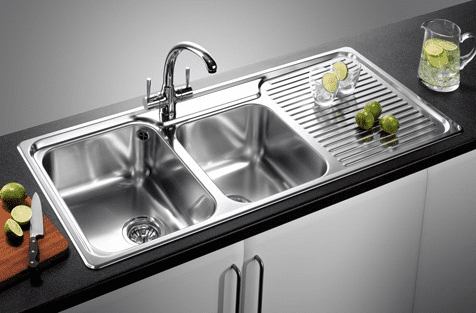
As mentioned, stainless steel has become one of the most popular materials used for building a kitchen sink. Why? Because the best characteristic of stainless steel sinks is that it practically goes with every countertop material. In addition, it acquires popularity due to its extraordinary features, affordability, and streamlined trendy design.
Besides these features, some people might think stainless sinks are plain and monotonous, while other people look at the functionality it has to provide. A functional stainless steel sink is -one having a smaller gauge number, meaning the steel is thicker and high-quality. For instance, opt for a 16-18 gauge steel if you want a robust and sturdy sink.
Furthermore, for kitchens particularly, you can consider getting a 300 series stainless steel because it is not magnetic. A 300 series steel comprises chromium and nickel, which helps prevent corrosion and sustain high temperatures. Beyond all these qualities, it does have some pros and cons.
| POSITIVES | NEGATIVES |
| Non-corrosive and highly durable | Susceptible to dents and scratch |
| Easy cleaning | Develops hard water stains |
| Hygienic and self-regenerating | Noisy |
| Relatively cheap | Limited variety in terms of color |
Composite
Another material having an ideal blend of long-lasting durability and contemporary appearance is composite sinks. As the name implies, these sinks are commonly composed of materials, such as quartz, granite, resin, or heavy plastic dust.
This composition of two materials allows the composite sinks to be resilient to the heat, and hence, there will be no traces of hot pots, pans, and other items on the sink surface. Why do homeowners prefer composite sinks? Because they look incredible without costing you a fortune.
The incredible look comes from a high-quality composite sink. A good quality composite has 80% quartz, granite, or other materials capable of making the sink resistant to heat, stain, and scratch. Typically, the smaller 20% materials contain acrylic-like particles as the bonding agent between the more solid materials. Mainly, composite sinks are found made of quartz and granite.
Quartz Composite
One of the main components for composite is quartz. Composite sinks made of quartz have 70% quartz sand (crushed) and acrylic resin. This combination leads to the solidity and non-porosity of the sink. Moreover, it is relatively light than cast iron and even more durable than stainless steel.
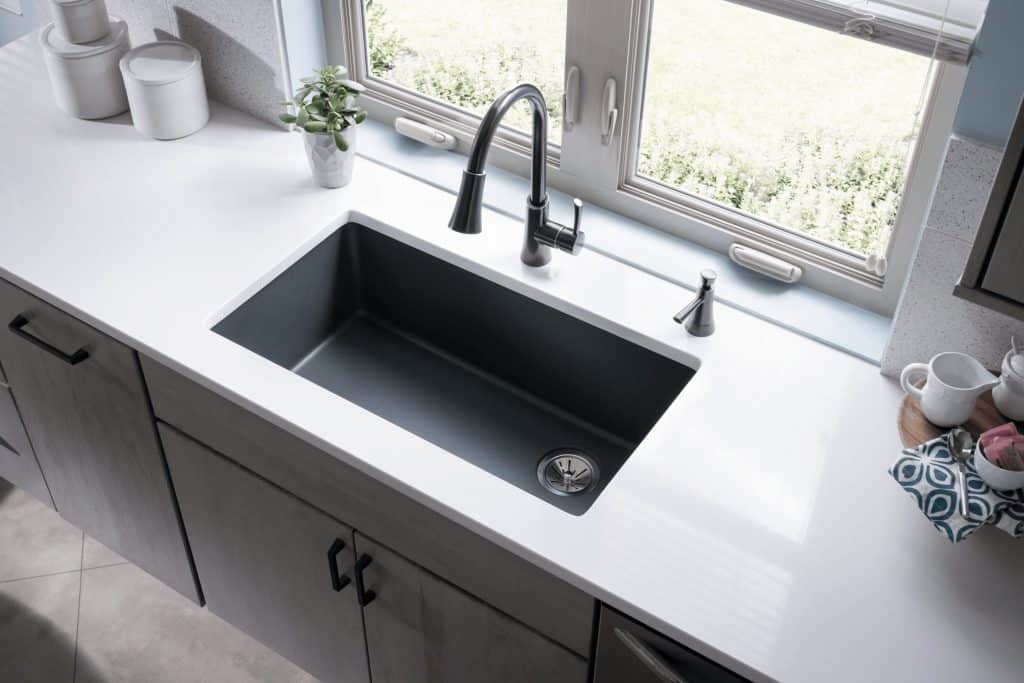
Granite Composite Sinks
Similar to quartz, composite granite sinks have 70% crushed granite and resin. However, granite with resin is dense and has more durability than quartz because granite is composed of different materials like feldspar, mica, and quartz.
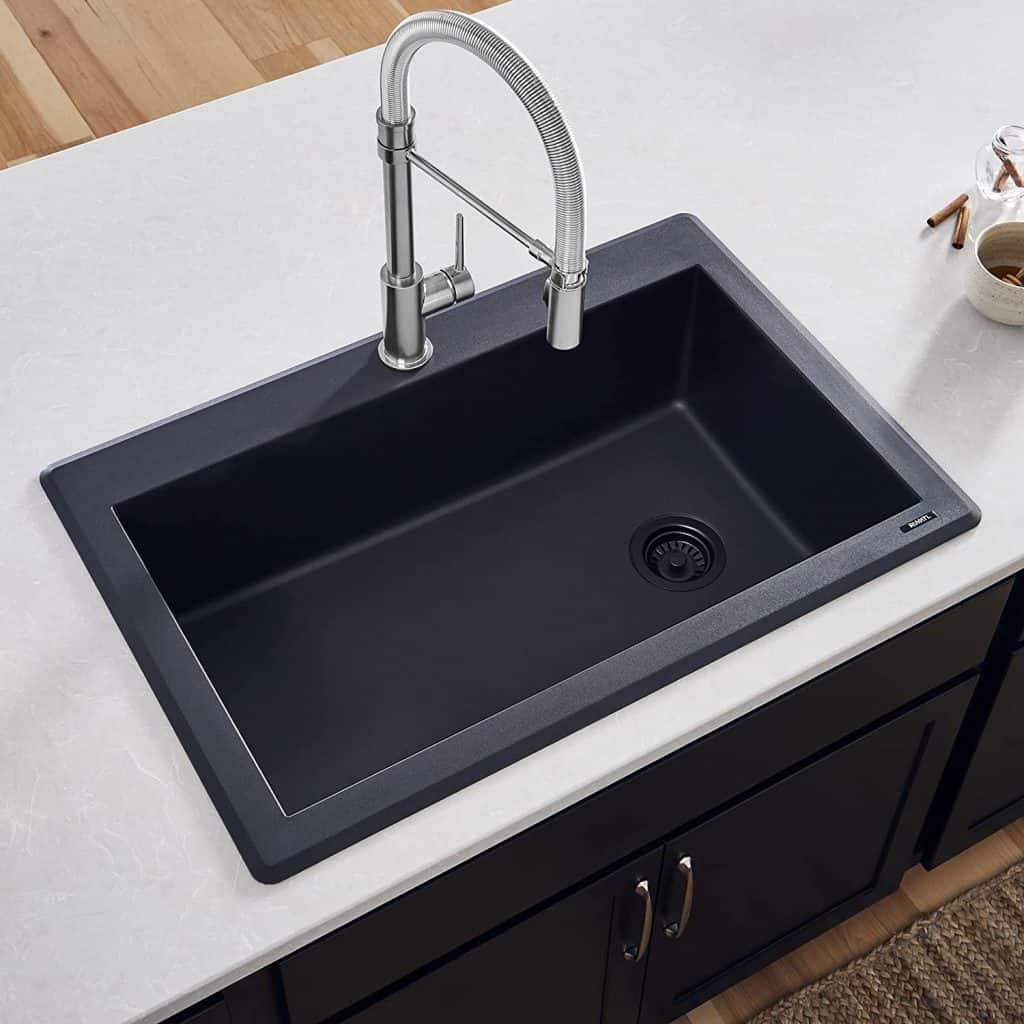
Even though both the sink materials are durable and seems to be a practical choice. Be it quartz or granite composite sinks, both have advantages and disadvantages.
| POSITIVES | NEGATIVES |
| Hard-wearing and durable | Sinks are heavy and bulky |
| Heat and stain-resistant | Susceptible to scratches, hard water stains |
| Easy to clean | Costly than stainless steel or porcelain |
| Variety of options to choose from | Needs maintenance |
Fireclay
Fireclay, a unique material, is created when clay gets fired with a glaze at extremely high temperatures (1600 degrees) in a kiln. The firing process produces a material resembling ceramic but provides more practical and functional qualities. It gives the fireclay sinks endurance, durability, and solidity.
Apart from that, fireclay sinks generally come in white or off-white colors. Although, there are dramatic black or blue available. Today, fireclay farmhouse or apron kitchen sinks are high in demand because of their glaze, malleability, and ease of cleaning.

One more reason why fireclay sinks are in demand is that each sink is handcrafted. Each sink is different and unique -enhancing the beauty of your home. Hence, they require high-precision installation that comes as an added expense. Listed below are some positive and negative points of fireclay sinks.
| POSITIVES | NEGATIVES |
| Highly durable and hard-wearing | Difficult installation |
| Resilient to stains and scratch | Heavy |
| Non-porous and solid | Available in limited colors and sizes |
| Easy to clean | High-priced |
Cast Iron
Another material that is created in extremely high temperatures, apart from fireclay, is cast iron. Sinks made from cast iron get their durability and are resilient to heat due to the high temperature used in the manufacturing process.
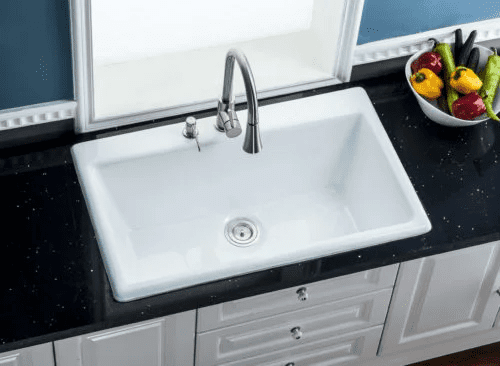
Furthermore, the sink gets a smooth and glossy finish because cast iron kitchen sinks have a coating of enameled porcelain. In addition to its gleaming appearance, porcelain coatings on iron protect it against water stains, scrapings, and scum buildup. The pros and cons of cast iron kitchen sinks are:
| POSITIVES | NEGATIVES |
| Available in many colors | The porcelain coating may chip or wear-off |
| Does not dent like stainless steel | Susceptible to rust |
| Easy installation | Heavy and massive |
| Easy to clean and care | Expensive |
Porcelain
One more clay-based sink material is porcelain. Traditionally, we see more porcelain sinks in the bathroom than in the kitchen vicinity. While cast iron sink has an enamel porcelain coating, sinks are also made of 100% solid porcelain or enamel porcelain.
INTERESTING FACT -For homeowners, porcelain offers an excellent middle ground. The reason is that cast-iron sinks are heavy, and stainless steel sinks are lightweight and noisy, so porcelain stands out more.
Due to the sink appearance, people confuse porcelain and ceramic to be the same. However, the difference lies within the manufacturing process of the sinks. Porcelain is manufactured by combining finer clay with higher pressures and baking at higher temperatures in a kiln.
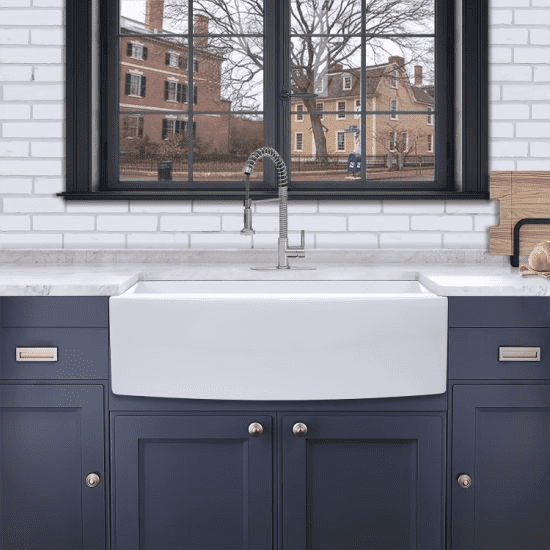
Hence, porcelain gets its quality features like durability and non-porosity from this manufacturing process. While there are benefits to porcelain, it also has a few drawbacks.
| POSITIVES | NEGATIVES |
| A wide range of colors is available | Susceptible to scratching |
| Easy to clean and maintain | Prone to chipping and cracking |
| Highly durable and long-lasting | Not stain-resistant |
| Relatively inexpensive | It might need reglazing from time to time |
Ceramic
Unlike porcelain, ceramic kitchen sinks are porous and water absorbent. The porosity comes from a blend of clays and fillers that creates a ceramic sink. Thus, no two ceramic kitchen sinks will be the same because of the manufacturing process and natural materials.
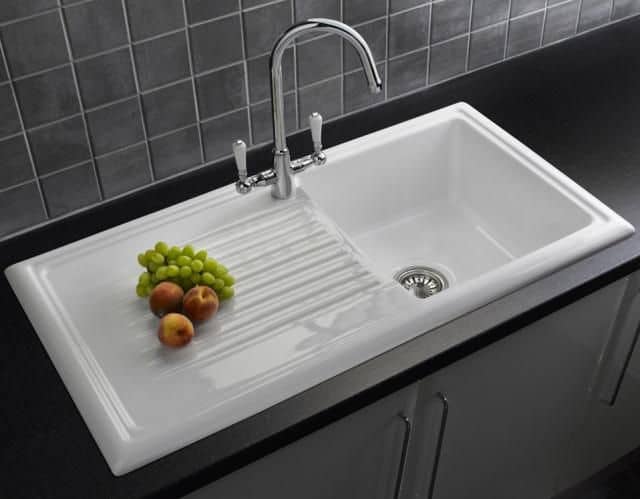
Ceramic kitchen sinks perfectly complement modern, contemporary, and rustic, traditional kitchen layouts. Given below are pros and cons you can expect while buying a ceramic sink.
| POSITIVES | NEGATIVES |
| Easy to clean and care | Prone to scratching |
| Durable | Highly susceptible to chipping and cracking |
| Tough and non-porous | Harsh chemicals and acids might wear off the glaze |
| Affordable | Not eco-friendly |
Copper
Kitchen sinks are not only made from clay, metals also contribute to the materials used for kitchen sinks. Fan of handcrafted and intricate patterns? A copper sink is your ideal choice. Not just beautiful, copper sinks are long-lasting, one-of-a-kind, and look absolutely stunning in the kitchens.
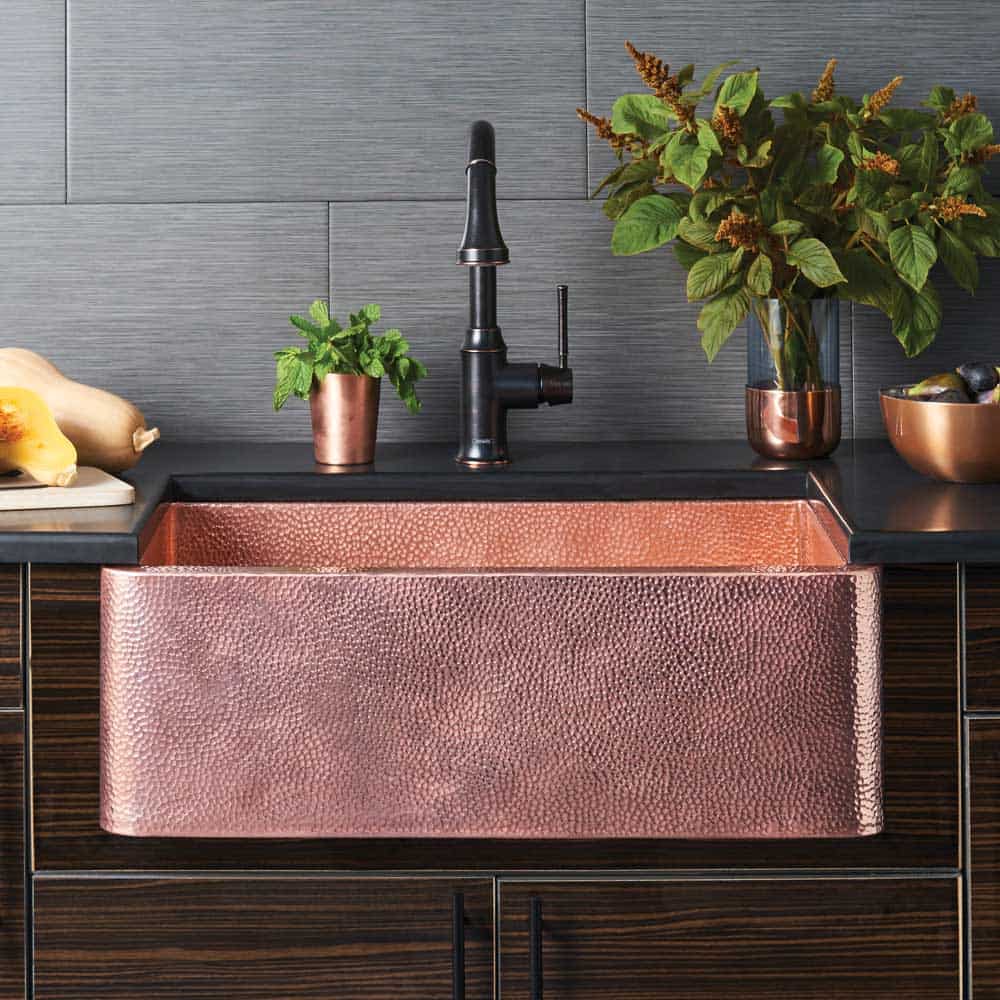
Many people believe that copper sinks are delicate and not made for heavy use per se. However, a high-quality copper sink is fashioned of 99% copper with 1% zinc for strength and durability.
In addition, copper kitchen sinks offer you the option of choosing -a smooth or hammered sink and a wide range of patinas. We already know about the health benefits copper has to offer. Copper also has the potential of naturally destroying 99.9% of germs.
| POSITIVES | NEGATIVES |
| Antimicrobial and hygienic | Demand high maintenance |
| Environment-friendly and recyclable | Susceptible to denting and scratching |
| Resilient to corrosion and rust | Highly sensitive to harsh chemicals & acid |
| Develops different colors of patina over time | Fairly overpriced |
Brass
Another metal sink showing practical features is brass. Brass sinks add charm to your kitchen with their aesthetic appeal and antimicrobial properties.
Want to install an eye-catching piece in your kitchen? A brass kitchen sink is probably your best choice because it is functional yet amazing-looking.
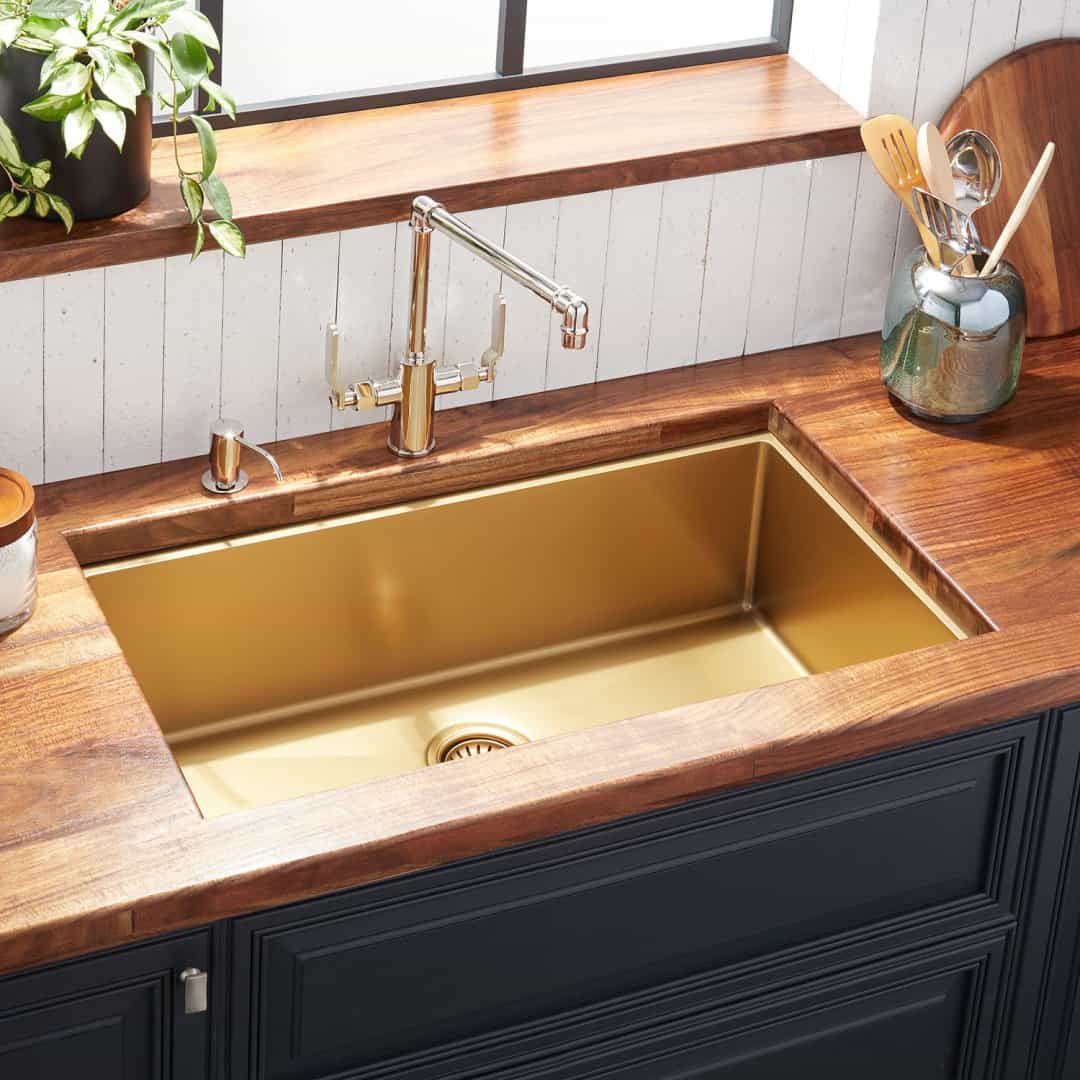
While brass is functional, it is more likely to dent, tarnish, scratch, and develop verdigris (green residues). Therefore, they need extra care and maintenance. But, brass sinks can be cleaned using simple natural methods. You can expect the following positive and negative points while getting a brass kitchen sink.
| Positives | Negatives |
| Classic, elegant appearance | Expensive (twice the cost of porcelain) |
| Durable only if properly maintained | Susceptible to scratches, dents, and stains |
| Non-corrosive surface | High-maintenance |
| Has antimicrobial and germicidal properties | Use of chemicals and acids may harm the surface |
Glass
After exploring the above materials, the glass may seem weird and non-functional material for a kitchen sink. However, tempered or turquoise glass can sustain heat and chemicals.
While the most common glass sinks types are vessel and bathroom, they are also available as undermount kitchen and bar sinks.
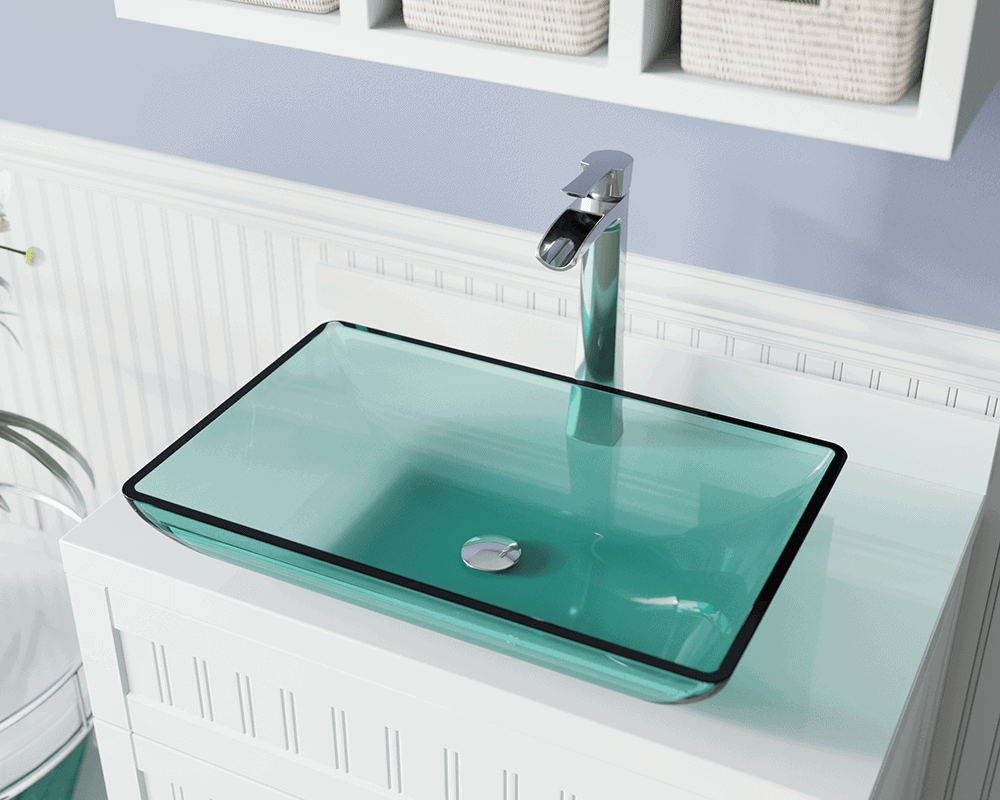
With that being said, in comparison to other kitchen sink materials, glass does not seem to be the most durable and practical material for a kitchen sink. For instance, once you drop heavy, sharp, and hot items, there is a chance that the glass might shatter. On the other side, glass bar sinks are known for their unique beauty.
For better understanding, take a look at the positives and negatives of a glass sink.
| POSITIVES | NEGATIVES |
| Classy, modern, trendy appearance | Quite expensive |
| Available in many colors and styles | Prone to scratching and limescale |
| Careful yet easy maintenance | Compared to other materials, low resistivity to heat |
| Stain-resistant | May shattered when the force applied |
Wood
Similar to glass, the thought of a customized sink made of wood may seem uncommon, but wooden farmhouse sinks, vessel sinks, and bathtubs have a long tradition in homes. Wooden sinks are exquisitely attractive, long-lasting, and sustainable.
For that reason, the sinks and bathtubs were originally fashioned entirely of raw teak wood, with no additional treatment.
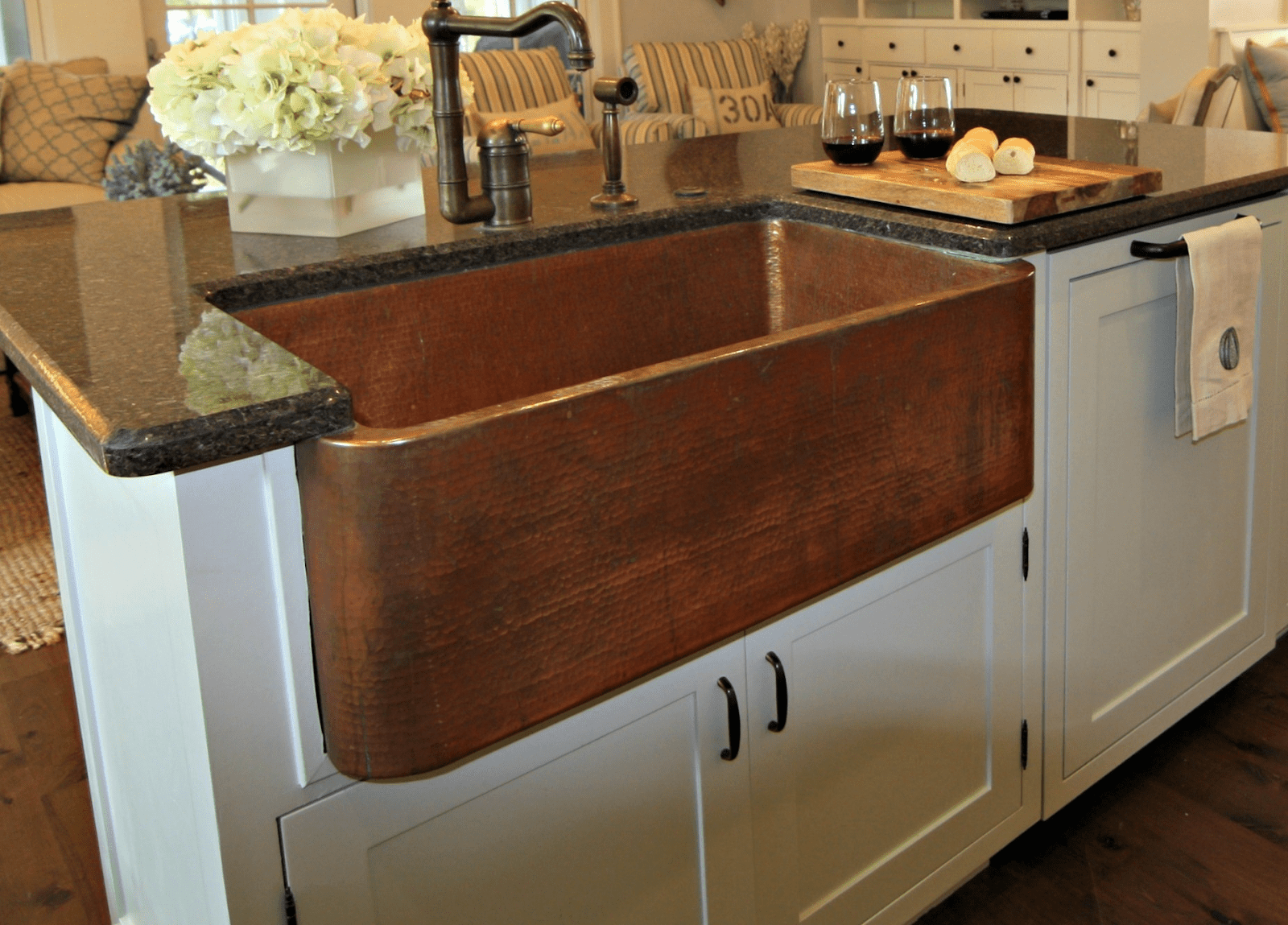
Wooden farmhouse kitchen sinks are often constructed for large sinks without dishwashers. Apart from appealing to the eyes, they allow washing many dishes at once. Some of the pros and cons of wooden sinks are:
| POSITIVES | NEGATIVES |
| Unique beauty and design | Prone to damage if not properly cared |
| It can be customized as per your taste | High maintenance |
| Durable, hard-wearing, stain-resistant | Fairly overpriced |
| Environmental friendly | Heavy and sharp items can harm the wood |
Bamboo
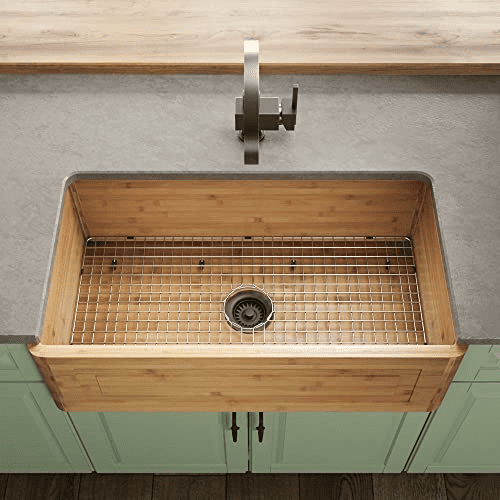
While wooden sinks are uncommon, bamboo sinks are more common and affordable than wood. It looks fantastic and is more durable.
Bamboo sinks are an excellent choice for a busy kitchen, as it is naturally waterproof. In addition, bamboo kitchen sinks are sturdy and strong. They are more durable than Red Oak and Maple wood in terms of durability. It also offers higher compressibility than steel without losing elegance.
| POSITIVES | NEGATIVES |
| Eco-friendly | Needs regular maintenance |
| Easy cleaning and maintenance | Susceptible to leakage |
| Unique styles and finishes | Sensitive to chemicals and acids |
| Comparatively cheaper | Limited colors |
Natural Stone
Natural stone kitchen sinks are stunning and unique -particularly when they’re apron-fronted to show off the texture and features.
Several factors, including cost, weight, and maintenance, make natural stone sinks rare. But, for not-so-busy kitchens or exclusively decorative sinks, they are a great choice.
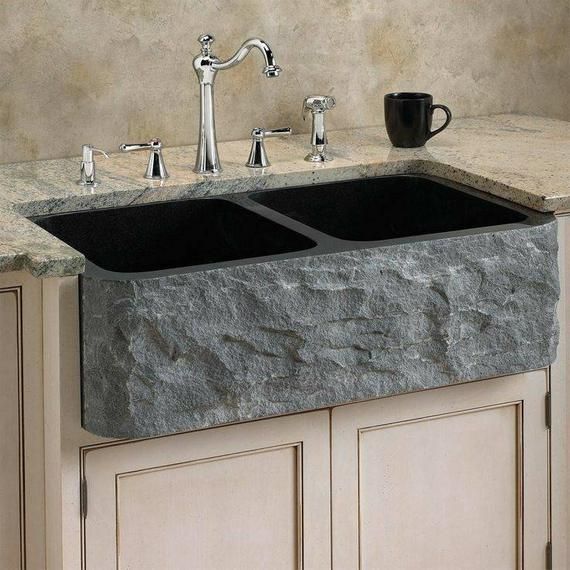
Mainly, natural stone kitchen sinks are made of:
- Marble
- Granite
- Soapstone
- Travertine
Sinks made of natural stone do not just function in the same way as those made of porcelain or steel, but they bring a sense of natural beauty and a natural feel to your home space. Even then, they do have some pros and cons.
| POSITIVES | NEGATIVES |
| Strong and durable | Heavy and bulky |
| Easy to care for and maintain | Although easy, it requires regular maintenance |
| Heat resistant | Tend to discolor and oxide |
| Versatile in nature | Expensive |
Acrylic
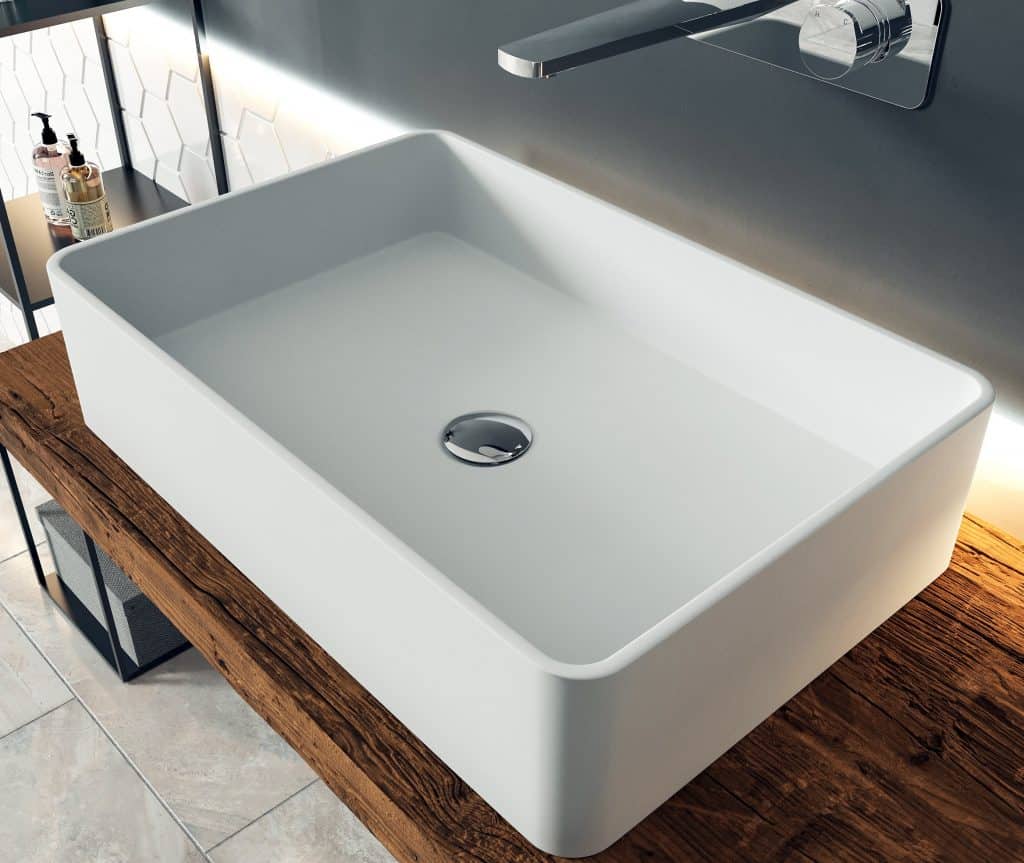
Acrylic is a type of plastic that is molded to make kitchen sinks. Acrylic kitchen sinks are a cost-effective substitute for metals, porcelain, and stone. They are starting to gain popularity for being lightweight and attractive.
Furthermore, acrylic sinks are available in various colors, sizes, and shapes, matching your kitchen decor. Acrylic, used in paint, windows, and even corner guards on walls, can also be fashioned into various home furniture.
| POSITIVES | NEGATIVES |
| Inexpensive | Not long-lasting like metals or porcelain |
| Resistant to stains | Highly sensitive to heat |
| Lightweight making installation easy | Cannot withstand petroleum-based materials |
| Easy to clean | Susceptible to scratching |
Final Thoughts
Comparing the positives and negatives of sink materials allows you to select the most dependable and durable sink material for your style. Some of the materials discussed are durable and resistant to various potential kitchen mishaps; others are elegant and customizable.
Hence, choosing the finest material for your kitchen necessitates considering several aspects. You should seek an option that complements your kitchen’s décor, demands, and budget.
![Ceramic vs Stainless Steel Sink [A Detailed Analysis] Ceramic vs Stainless Steel Sink [A Detailed Analysis]](https://houseadorable.com/wp-content/uploads/2021/12/Ceramic-vs-ss.jpg)
![Fireclay Vs Stainless Steel Sinks[7 Key Differences+Pros & Cons] Fireclay Vs Stainless Steel Sinks[7 Key Differences+Pros & Cons]](https://houseadorable.com/wp-content/uploads/2022/01/Fireclay-sink-3.jpg)
![Granite Vs. Marble Vs. Quartz Countertops [12 Differences+Pros & Cons] Granite Vs. Marble Vs. Quartz Countertops [12 Differences+Pros & Cons]](https://houseadorable.com/wp-content/uploads/2022/03/quartz-marble.jpg)
![Chrome Vs. Stainless Steel Faucets: [An In-Depth Analysis] Chrome Vs. Stainless Steel Faucets: [An In-Depth Analysis]](https://houseadorable.com/wp-content/uploads/2023/03/51gDGcVWBL._AC_UF10001000_QL80_-250x250.jpg)
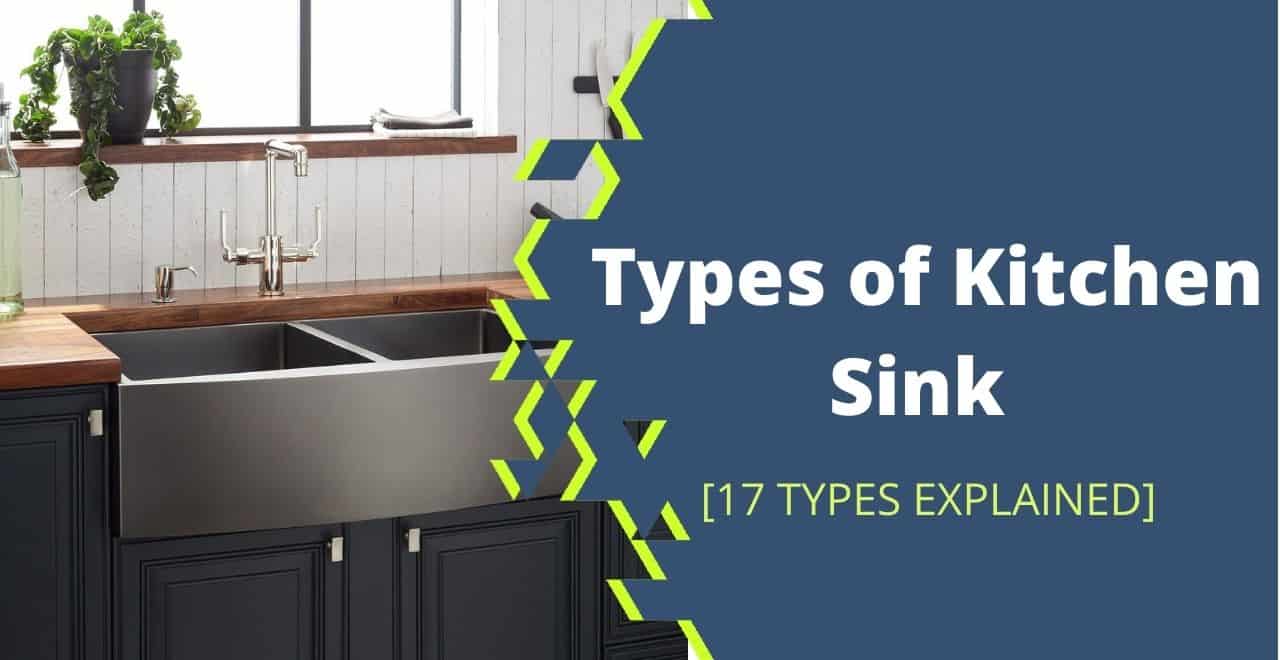
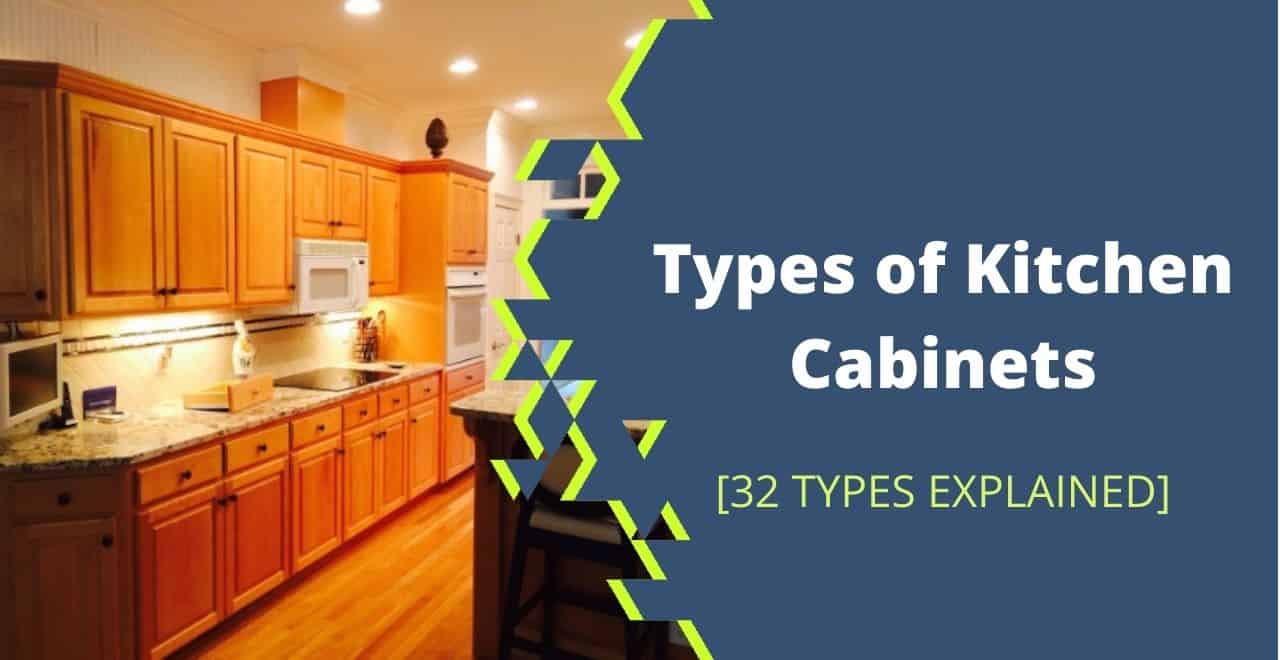

![How Much Does It Cost to Build a Kitchen Island? [Custom Made+DIY] How Much Does It Cost to Build a Kitchen Island? [Custom Made+DIY]](https://houseadorable.com/wp-content/uploads/2022/03/cost-of-kitchen-island.jpg)